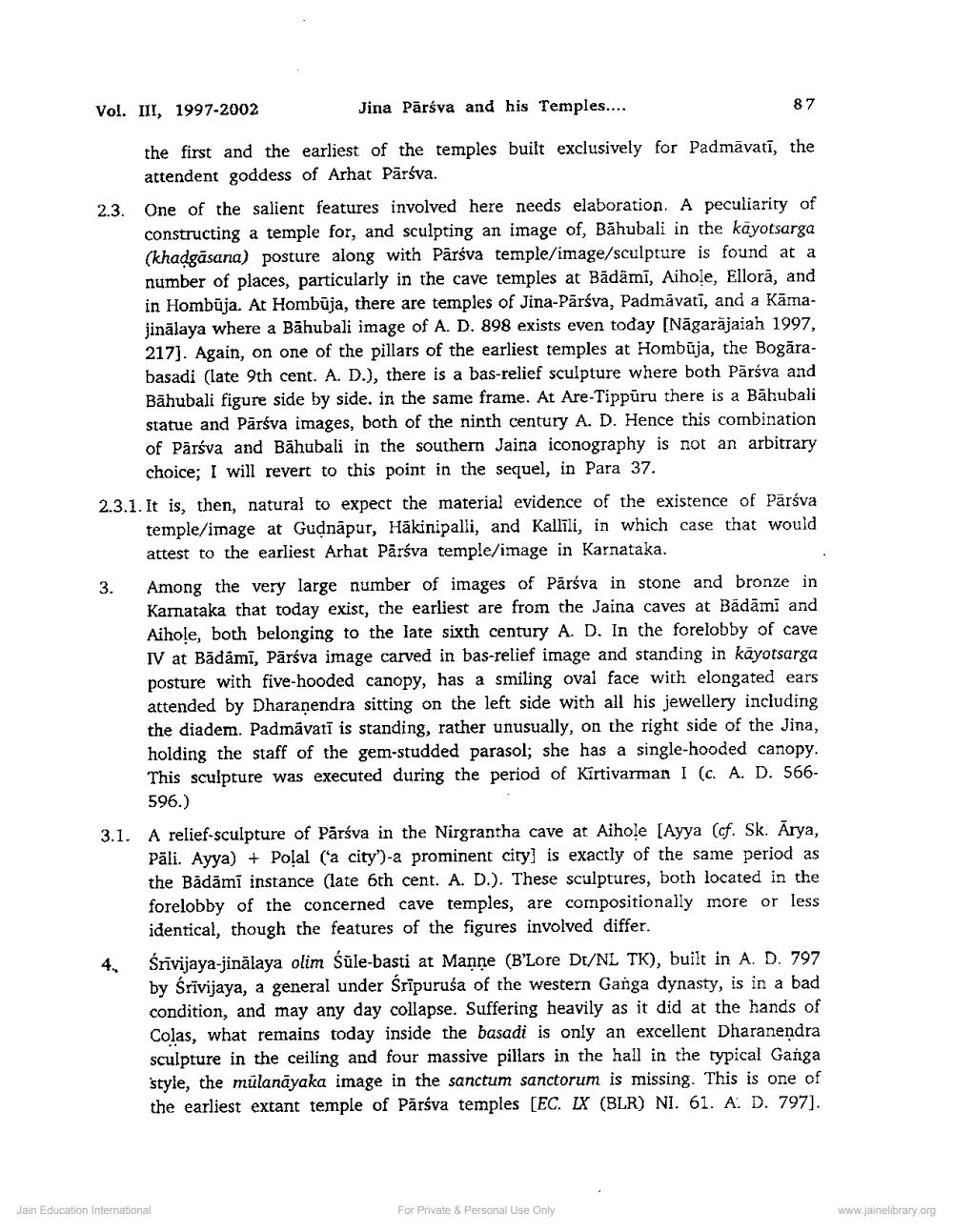Book Title: Jin Parsva and His Temples in Inscriptions of Karnataka Author(s): Hampa Nagrajaiha Publisher: Z_Nirgrantha_1_022701.pdf and Nirgrantha_2_022702.pdf and Nirgrantha_3_022703.pdf View full book textPage 4
________________ Vol. III, 1997-2002 Jina Pārśva and his Temples.... 87 the first and the earliest of the temples built exclusively for Padmāvatī, the attendent goddess of Arhat Pārsva. 2.3. One of the salient features involved here needs elaboration. A peculiarity of constructing a temple for, and sculpting an image of, Bahubali in the kāyotsarga (khadgāsana) posture along with Pārsva temple/image/sculpture is found at a number of places, particularly in the cave temples at Bādāmī, Aihole, Elloră, and in Hombūja. At Hombūja, there are temples of Jina-Pārśva, Padmavatī, and a Kāmajinālaya where a Bāhubali image of A. D. 898 exists even today [Nāgarājaiah 1997, 217]. Again, on one of the pillars of the earliest temples at Hombūja, the Bogārabasadi (late 9th cent. A. D.), there is a bas-relief sculpture where both Pärśva and Bahubali figure side by side. in the same frame. At Are-Tippuru there is a Bahubali statue and Pārsva images, both of the ninth century A. D. Hence this combination of Pārśva and Bāhubali in the southern Jaina iconography is not an arbitrary choice; I will revert to this point in the sequel, in Para 37. 2.3.1. It is, then, natural to expect the material evidence of the existence of Pārsva temple/image at Gudnapur, Hākinipalli, and Kallīli, in which case that would attest to the earliest Arhat Pārśva temple/image in Karnataka. Among the very large number of images of Pärśva in stone and bronze in Karnataka that today exist, the earliest are from the Jaina caves at Bādāmi and Aihole, both belonging to the late sixth century A. D. In the forelobby of cave IV at Bādāmī, Pārsva image carved in bas-relief image and standing in kayotsarga posture with five-hooded canopy, has a smiling oval face with elongated ears attended by Dharanendra sitting on the left side with all his jewellery including the diadem. Padmāvatī is standing, rather unusually, on the right side of the Jina, holding the staff of the gem-studded parasol; she has a single-hooded canopy. This sculpture was executed during the period of Kirtivarman I (c. A. D. 566 596.) 3.1. A relief-sculpture of Pārśva in the Nirgrantha cave at Aihole (Ayya (cf. Sk. Ārya, Pāli. Ayya) + Polal (a city')-a prominent city) is exactly of the same period as the Bādāmī instance (late 6th cent. A. D.). These sculptures, both located in the forelobby of the concerned cave temples, are compositionally more or less identical, though the features of the figures involved differ. Śrīvijaya-jinālaya olim Süle-basti at Manne (B’Lore D[/NL TK), built in A. D. 797 by Śrīvijaya, a general under Śrīpuruśa of the western Ganga dynasty, is in a bad condition, and may any day collapse. Suffering heavily as it did at the hands of Colas, what remains today inside the basadi is only an excellent Dharanendra sculpture in the ceiling and four massive pillars in the hall in the typical Ganga style, the mulanāyaka image in the sanctum sanctorum is missing. This is one of the earliest extant temple of Pārśva temples (EC. LX (BLR) NI. 61. A D. 797]. Jain Education International For Private & Personal Use Only www.jainelibrary.orgPage Navigation
1 2 3 4 5 6 7 8 9 10 11 12 13 14 15 16 17 18 19 20 21 22 23
